Students can access the CBSE Sample Papers for Class 12 Informatics Practices with Solutions and marking scheme Term 2 Set 3 will help students in understanding the difficulty level of the exam.
CBSE Sample Papers for Class 12 Informatics Practices Term 2 Set 3 with Solutions
Maximum Marks : 35
Time : 2 hours
Instructions:
- The question paper is divided into 3 sections – A, B and C.
- Section A, consists of 7 questions (1-7). Each question carries 2 marks.
- Section B, consists of 3 questions (8-10). Each question carries 3 marks.
- Section C, consists of 3 questions (11-13). Each question carries 4 marks.
- Internal choices have been given for question numbers -1, 3, 8 and 12.
Section – A
(Each question carries 2 Marks)
Question 1.
Jitendra, while looking at a web page found that some of the components were not working . The website prompted to install certain plug-ins to the browser. Explain the term plug-ins and why they are needed?
Or
Mr. Navneet found that his login id and password are automatically appearing on keypress in the login page. Explain him how cookies are responsible for this and how they are useful?
Answer:
Browser extensions and plug-ins are generally similar. They are software components (sometimes called “add-ons”) that add features to an existing computer program. These plug-ins allow you to do things in your browser such as view PDF files or watch videos on sites such as Netflix.
Or
Cookies are files created by websites you visit. They make your online experience easier by saving browsing information.
With cookies, sites can keep you signed in, remember your site preferences and give you locally relevant content. The purpose of the computer cookie is to help the website keep track of your visits and activity.
![]()
Question 2.
(i) Looking for network devices that are required for running of a computer network Ms. Rashmi found a device called Modem. Explain her the role of Modem in a network.
Answer:
Modem is abbreviation for Modulator Demodulator. Modems are used for data transfer from one computer network to another computer network through telephone lines. The computer network works in digital mode, while analog technology is used for carrying messages across phone lines. Modem converts from analog to digital and digital to analog.
(ii) The employees of WoodCorp Ltd. were steadily facing the problem of weak signals. The network engineer suggested installation of repeaters. Explain them the use of repeater in a network.
Answer:
Repeater is a network device that retransmits the data from sender to the receiver side of the network. The incoming data can be in the form of wireless, electrical signals and optical signals. The repeaters transfer the data through a large area distance. The repeaters ensures the security and quality of the data and retransmits the data by securely preserving the signals. For the longer distance data transmission, the repeaters are used without compromising the security and quality of data.
Question 3.
Mahi wanted to find the data from a student table with certain formattings on the data using some MySQL functions.
The table structure is as follows
STUDENT (RollNo, Name, Class, Stream, Percentage)
(i) To display the 3rd to 7th characters of name attribute.
(ii) To display the name of each student in uppercase letters with their RollNo, whose percentage is greater than 70.
Or
Snigdha has some confusions regarding the working of LEFT() and RTRIM() functions. Help her in finding the outputs of following statements.
(i) mysql >SELECT LEFT (’Swati’,4);
(ii) mysql>SELECT RTRIM (‘!!!!!Study is important!!!!!’);
Answer:
(i) SELECT SUBSTR( Name, 3,5) FROM STUDENT;
(ii) SELECT UCASE( Name), Roll No FROM
STUDENT WHERE Percentage>70;
Or
(i)

(ii)

Question 4.
Jim heard the term topology and could not make out how this term is related to networks. Explain him the term topology, its types and various topologies used.
Answer:
In networking, topology refers to the layout of a computer network. Physical topology means the placement of the elements of the network, including the location of the devices or the layout of the cables. Logical topology maps the flow of data, regardless of the physical layout.
Few topologies are – Star, Bus, Ring, Tree, etc.
Question 5.
(i) Ms. Sudha a database operator wants to find the maximum and minimum values from a column test_score of a table. Explain how the MAX() and MIN() functions can help her ?
(ii) She also wants to find the average of the test_score and the count of records in the table, provide her the explanation of AVG() and COUNT() functions, so that she can get her desired results.
Answer:
MAX([DISTINCT I All] expr) It returns the maximum value of expr. MAX() may take a string argument, in such cases, it returns the maximum string value. The DISTINCT keyword can be used to find the maximum of the distinct values of expr, however this produces the same result as omitting DISTINCT. MAX() returns NULL, if there were no matching rows,
e.g.
mysql> SELECT MAX(test_score) FROM STUDENT;
MIN([DISTINCTI All]expr) It returns the minimum value of expr. MIN() may take a string argument, in such cases, it returns the minimum string value. The DISTINCT keyword can be used to find the minimum of the distinct values of expr, however this produces the same result as omitting DISTINCT. MIN() returns NULL, if there were no matching rows.
e.g.
mysql> SELECT MIN(test_score) FROM STUDENT;
(ii) AVG ([DISTINCT]expr) It returns the average value of expr. The DISTINCT option can be used as of MySQL to return the average of the distinct values of expr. AVG() returns NULL, if there were no matching rows.
e.g.
mysql> SELECT AVG(test_score) FROM STUDENT;
COUNT(expr) It returns a count of the number of non NULL values of expr in the rows retrieved by a SELECT statement. The result is a BIGINT value.
COUNT() returns 0, if there were no matching rows. COUNT(*) is somewhat different in that it returns a count of the number of rows retrieved, whether or not they contain NULL values.
e.g.
mysql > SELECT COUNT (*) FROM STUDENT;
The query would give the output, total number of rows in STUDENT table. COUNT( [DISTINCT] expr) It returns a count of the number of rows with different non NULL expr values.
COUNT(DISTINCT) returns 0, if there were no matching rows,
e.g.
mysql> SELECT COUNT(DI ST INCT results) FROM STUDENT; .
![]()
Question 6.
Shyam was interrogated by his teacher in a viva about the differences between single-row functions and multiple-row functions. He could not answer the questions. Help shyam in figuring out four differences.
Answer:
| Single-row functions | Multiple-row functions / Aggregate functions |
| 1. It operates on a single row at a time. | 1. It operates on multiple rows. |
| 2. It returns one result per row. | 2. It returns one result for multiple rows. |
| 3. It can be used in SELECT, WHERE and ORDER BY clause. | 3. It can be used in the SELECT clause only. |
| 4. Mathematical, String and Date functions are examples of single-row functions. | 4. MAX(), MIN(), AVG(), SUM(), COUNT() and COUNT(*) are examples of multiple-row functions. |
Question 7.
Mr. Roy is a manager in a hotel and wants to find out some data from a table where he maintains the hotel records. He is not very expert with SQL commands and functions. Help him to write the queries.
Table: Hotel

(i) Display count of the different room types from the table Hotel.
(ii) Display the average room charges of “AC” rooms.
Or
(i) Display the count of Dtof Arrival from the table Hotel.
(ii) Display the minimum charges.
Answer:
(i) SELECT COUNT(DISTINCT RoomType) FROM Hotel;
(ii) SELECT AVG(Charges) FROM Hotel WHERE RoomType=“AC”;
Or
(i) SELECT COUNT(DtofArrival ) FROM Hotel;
(ii) SELECT MIN(Charges) FROM Hotel;
Section – B
(Each question carries 3 Marks)
Question 8.
Samriddhi is a database operator at New Software Systems Inc. She wants to understand the working of certain MySQL functions. She has wrote following MySQL statements and wants to understand the outputs. Help her to predict the outputs of the following statements.
(i) SELECT SUBSTR(‘Informaticspractices’ ,-10, 2);
(ii) SELECT ROUND(1999.98, 1);
(iii) SELECT TRUNCATE(1778.89, -1 );
Or
(i) SELECT POW( 11, 2);
(ii) SELECT P0W( 2 , -2);
(iii) SELECT POW(19.5, 6);
Answer:

Or
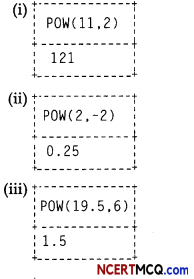
![]()
Question 9.
Naina works for M/s Anish Steels Ltd. She has written following statements, but is not able to understand the outputs. Explain her the working of these statements and produce the outputs.
(i) SELECT INSTRC ‘computerscience’ , ‘sc’);
(ii) SELECT MID( ‘ f unandfood ’, 3,4);
(iii) SELECT ROUNDC1334.99) ;
Answer:
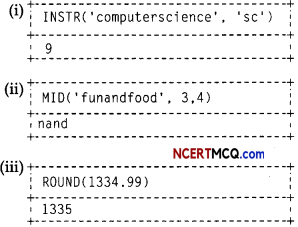
Question 10.
Certain Date/Time and numeric functions trouble Sunil and he is not able to understand and implement properly the functions. Help him with the outputs of the following commands.
(i) SELECT M0D( 12,7);
(ii) SELECT M0NTH(‘2012-09-12’) ;
(iii) SELECT YEAR( ‘2021 -01 -01′);
Answer:
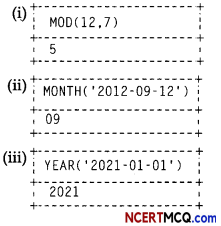
Section – C
(Each question carries 4 Marks)
Question 11.
While working with records of students, to find aggregate results, Mr. Akashdeep wrote some queries using MySQL functions, but is not sure about the outputs produced. Help him to find the proper outputs of the statements given below.
Table: Student
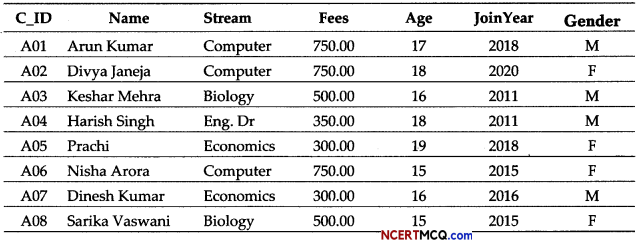
(i) SELECT Name, JoinYear FROM Student WHERE Gender — ‘F’ AND C_ID=’A02’;
(ii) SELECT MIN (JoinYear) FROM Student WHERE Gender — ‘M’;
(iii) SELECT AVG(Fee) FROM Student WHERE C_ID=’AO1’ OR C_ID=’A05’;
(iv) SELECT SUM(Fee) FROM Student WHERE Stream=”Computer”;
Answer:
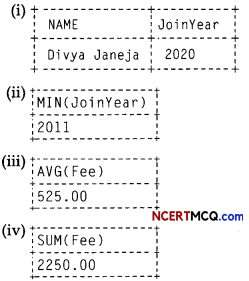
![]()
Question 12.
The IT department of Doctor’s Hub maintains the following Hospital table for patient records. They are in the process of producing some reports, department wise to analyse the performance and expenses of its various departments. Help them with SQL queries using aggregate functions and GROUP BY clause to get the required results.
Table: Hospital

(i) Display the department wise number of patients.
(ii) Display the unique department names.
(iii) Display the department wise maximum charges.
(iv) Display department wise average charges.
Or
Help the IT department in finding the outputs of the queries given below with respect to the table Hospital given above.
(i) SELECT Dept, MIN (Charges)FROM Hospital GROUP BY Dept;
(ii) SELECT COUNT(DISTINCt Dept) FROM Hospital;
(iii) SELECT MAX(Charges) FROM Hospital WHERE Dept=“0rtho”;
(iv) SELECT SUM(Charges)FROM Hospital WHERE Charges>4000;
Answer:
(i) SELECT Dept, COUNT!*) FROM Hospital GROUP BY Dept;
(ii) SELECT DISTINCT Dept FROM Hospital ;
(iii) SELECT Dept, MAX(Charges) FROM Hospital GROUP BY Dept;
(iv) SELECT Dept, AVG(Charges) FROM Hospital GROUP BY Dept;
Or
(i)
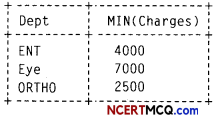
The records are grouped by Department and MIN(charges) finds the minimum in each group.
(ii)

COUNT (DISTINCT Dept) finds the count of unique departments.
(iii)

The MAX(Charges) finds the maximum charges in Ortho department.
(iv)

The SUM(Charges) finds the sum of the charges, where charges are more than 4000.
![]()
Question 13.
Red Pandas Infosystems has its 4 blocks of buildings . The number of computers and distances between them is given below
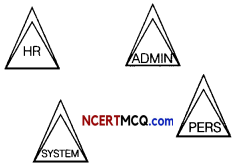
| Building | Number of Computers |
| HR | 15 |
| ADMIN | 100 |
| SYSTEM | 25 |
| PERS | 30 |
| Building | Distance |
| HR-ADMIN | 10m |
| HR- SYSTEM | 50m |
| HR- PERS | 750m |
| ADMIN- SYSTEM | 300m |
| ADMIN- PERS | 20m |
| SYSTEM-PERS | 250m |
Answer the following questions with respect to the above scenario.
(i) Suggest a suitable cable layout for the network.
Answer:
The cable layout is given below:
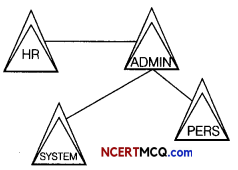
Since the ADMIN building has the maximum number of computers, connecting to it will ensure best connectivity.
(ii) Suggest the best place to house the server of the network.
Answer:
ADMIN building, as it has the maximum number of computers.
(iii) Which topology should be used to connect computers in each building?
Answer:
Star topology, as it is the topology offering best facilities.
(iv) What kind of network will be formed here (LAN/MAN/WAN)?
Answer:
LAN (Local Area Network)